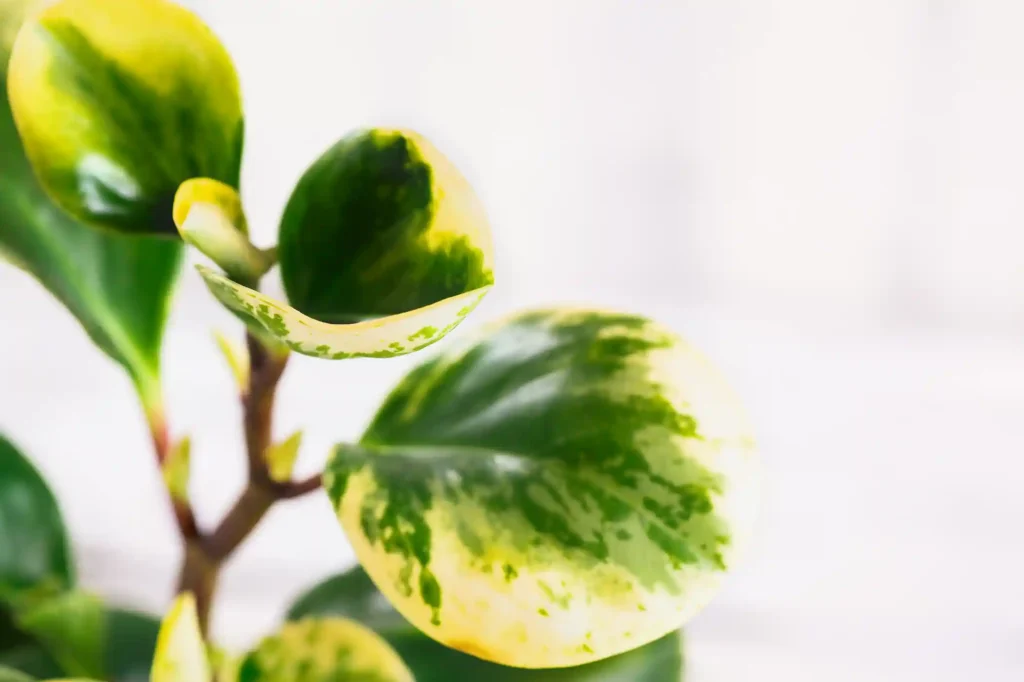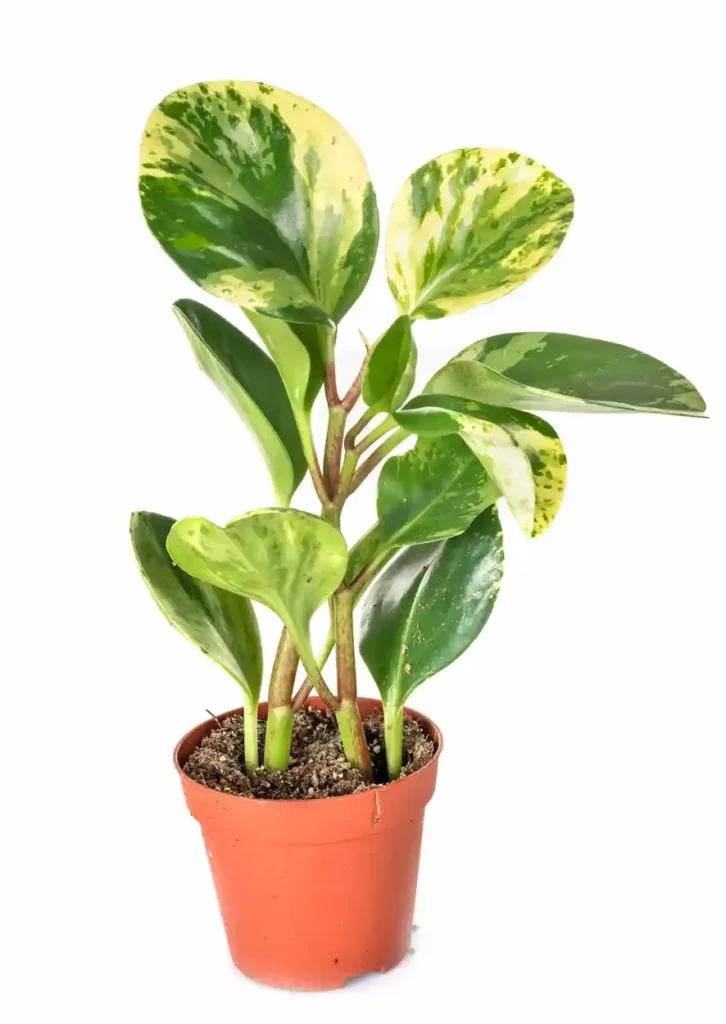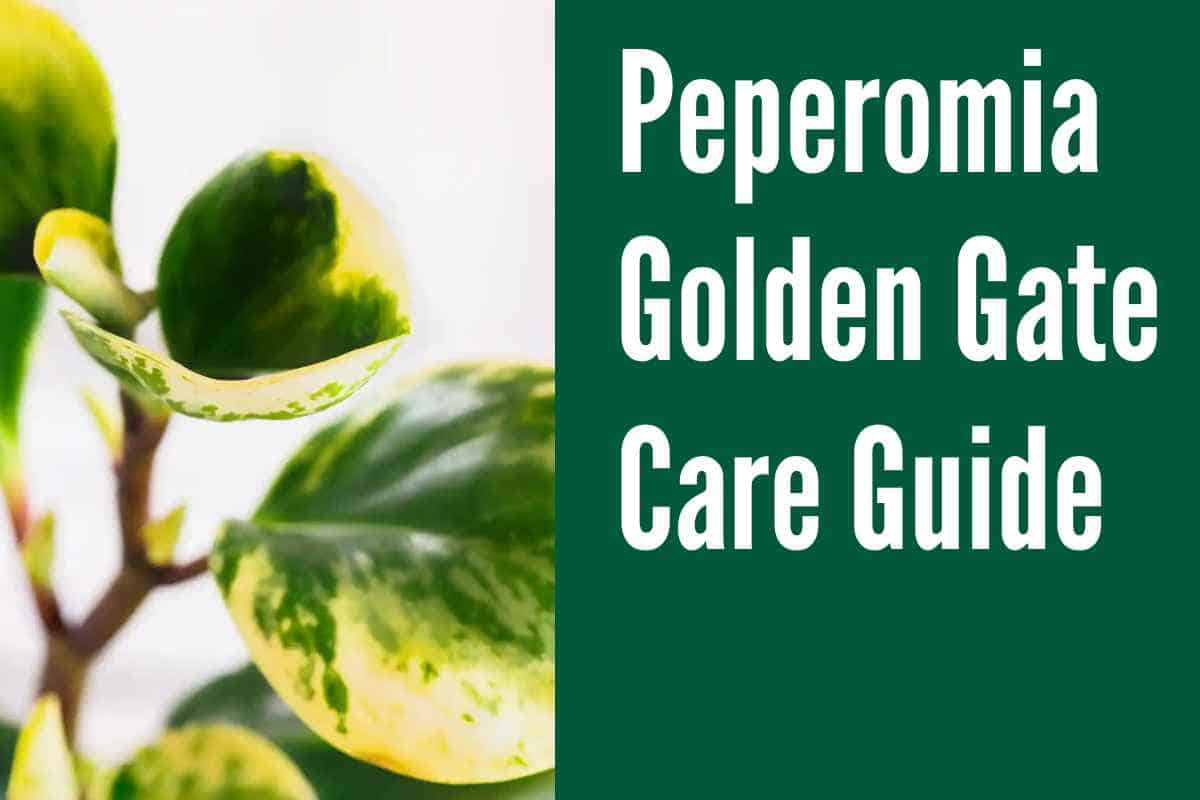Hey there plant lovers! Today, I want to talk to you about Peperomia Golden Gate care. If you want to add a gilded elegance to your indoor garden, this is the plant for you. With its golden-edged leaves, it’s sure to catch everyone’s attention.
Caring for Peperomia Golden Gate may seem like a daunting task, but fear not! I’m here to provide you with all the care tips and instructions you need to keep your plant thriving and looking its absolute best. Trust me, it’s easier than you think!
Key Takeaways:
- Ensure your plant receives bright, indirect light and maintain a temperature range between 68°F and 86°F (20°C-30°C).
- Water your plant moderately, allowing the top 2-3 inches of soil to dry out between waterings.
- Use a well-draining soil mix and avoid overwatering to prevent root rot.
- Regularly inspect your plant for pests and diseases, and take prompt action if necessary.

See Also:
Understanding Peperomia Golden Gate
Peperomia Golden Gate is a captivating variety of the Peperomia plant family, known for its golden-edged leaves. As a member of the Peperomia genus, which houses over 1,500 species, Peperomia Golden Gate exhibits unique growth behaviors and comes in various leaf shapes and colors, making it a popular choice among plant enthusiasts. This epiphytic plant thrives in indoor environments, adding a touch of elegance to any space.
Native to tropical regions, Peperomia Golden Gate belongs to a group of plants categorized based on their water conservation abilities: epiphytes, lithophytes, and xerophytes. Epiphytic plants like the Golden Gate variety grow on other plants but do not rely on them for nutrients, drawing moisture and nutrients from the air and rain. This adaptation allows them to flourish in indoor environments, complementing any interior with their unique foliage.
Growth Behaviors
Peperomia Golden Gate exhibits compact and bushy growth habits, making it a low-maintenance plant. Its leaves are thick and fleshy, storing water and nutrients for extended periods.
This attribute, combined with its ability to tolerate lower light conditions, makes it an ideal choice for indoor gardening. Whether placed in a bright corner or a partially shaded area, Peperomia Golden Gate will adapt and thrive.
Light and Temperature Requirements for Peperomia Golden Gate Care
Proper lighting and temperature are essential for the health and growth of Peperomia Golden Gate plants. Here are the recommended light requirements and temperature range for this stunning houseplant:
Light Requirements
Peperomia Golden Gate thrives in bright, indirect light. It should be placed in a location that receives moderate to bright light, but not direct sunlight. Direct sunlight can scorch the leaves, so it’s best to avoid exposing the plant to harsh afternoon sun.
Instead, place it near a window where it can receive filtered or indirect sunlight throughout the day. This will ensure that the plant gets the right amount of light it needs to thrive.
Temperature Range
Peperomia Golden Gate prefers temperatures between 68°F and 86°F (20°C-30°C). It is important to provide a stable temperature for the plant, avoiding extreme fluctuations.
Keep the plant away from drafts, as sudden changes in temperature can cause stress to the plant. The ideal temperature range will provide the optimal conditions for growth and ensure the plant remains healthy and happy.
By providing the right amount of light and maintaining the ideal temperature, you can create a favorable environment for your Peperomia Golden Gate plant to flourish.
| Light Requirements | Temperature Range |
|---|---|
| Bright, indirect light; avoid direct sunlight | 68°F – 86°F (20°C – 30°C) |

Watering and Soil Requirements
When it comes to watering your Peperomia Golden Gate, it’s important to strike a balance. This plant has moderate water requirements, so it’s best to allow the top 2-3 inches of soil to dry out between waterings. Overwatering can lead to root rot, so make sure the soil has proper drainage to prevent waterlogged conditions.
For the ideal soil conditions, Peperomia Golden Gate thrives in well-draining soil that retains some moisture without becoming waterlogged. Look for a well-aerated potting mix that allows excess water to flow out, ensuring the roots don’t sit in stagnant water.
Peperomia Golden Gate Care Soil Requirements
Peperomia Golden Gate prefers a light, well-draining soil mix that consists of equal parts of peat moss, perlite, and regular potting soil. This combination provides good moisture retention while allowing excess water to drain freely.
When it comes to watering frequency, it’s important to consider the environmental conditions. Factors such as temperature, humidity, and air circulation can affect the rate at which the soil dries out. Use your finger to feel the top layer of soil and water the plant when it feels dry to the touch. Remember, it’s better to underwater than overwater your Peperomia Golden Gate.
| Watering Guidelines for Peperomia Golden Gate | Visual Clues |
|---|---|
| Watering Frequency | Allow the top 2-3 inches of soil to dry out between waterings. |
| Watering Amount | Water thoroughly until the excess water drains out of the pot. |
| Watering Method | Water the plant at the base, avoiding the leaves to prevent fungal diseases. |
By following these watering and soil guidelines, you can ensure that your Peperomia Golden Gate receives the right amount of moisture to thrive and maintain its stunning appearance.
Propagation Techniques
Propagating Peperomia Golden Gate is a rewarding and fun way to expand your plant collection. There are several methods you can use to propagate this beautiful variety.
Stem Cuttings
Stem cuttings are the most common and easiest way to propagate Peperomia Golden Gate. To propagate using stem cuttings, simply take a healthy stem with at least two leaf nodes. Remove any lower leaves, as they may rot in the propagation process. Place the cutting in water or directly in well-draining soil. Keep the soil moist or change the water every few days until roots develop, which usually takes a few weeks. Once the roots have formed, you can transfer the cutting to its own pot.
Leaf Cuttings
Leaf cuttings are another popular method for propagating Peperomia Golden Gate. Simply select a healthy leaf and gently remove it from the mother plant. Place the leaf, with the petiole (stem) intact, into a pot filled with moist soil. Keep the soil consistently moist but not waterlogged. After a few weeks, the leaf should develop roots and small plantlets. You can either keep the plantlets attached to the leaf or separate them and pot them individually.
Division
Division is a method that works well for mature Peperomia Golden Gate plants that have developed multiple stems or rosettes. Gently remove the plant from its pot and carefully separate the stems or rosettes. Make sure each division has its own roots and replant them into individual pots filled with well-draining soil. Water the newly divided plants thoroughly and place them in a location with bright, indirect light.
| Propagation Method | Advantages | Disadvantages |
|---|---|---|
| Stem Cuttings | Easiest and quickest method | Not all cuttings may root successfully |
| Leaf Cuttings | Can produce multiple plantlets from a single leaf | Rooting success can vary |
| Division | Allows for immediate separation of plants | Only suitable for mature plants |

Pruning and Maintenance
When it comes to keeping my Peperomia Golden Gate looking its best, regular pruning and maintenance are key. While this plant doesn’t require extensive pruning, removing any damaged or diseased leaves is important for its overall health. By doing so, I ensure that my Peperomia Golden Gate remains vibrant and pest-free.
To begin, I carefully inspect the plant for any leaves that show signs of damage or diseases such as discoloration or wilting. Using a clean pair of scissors or pruning shears, I gently remove these leaves at the base, being careful not to damage the healthy parts of the plant. This simple pruning practice helps maintain the plant’s aesthetic appeal and prevents any potential spread of pests or diseases.
In addition to pruning, I also take steps to maintain the overall health and appearance of my Peperomia Golden Gate. Regularly dusting the leaves with a soft cloth or using a gentle spray of water helps keep them clean and free from any accumulated dirt or dust. I also keep an eye out for common pests such as spider mites or mealybugs and take immediate action if I notice any signs of infestation.
Peperomia Golden Gate Care Maintenance Tips:
- Regularly inspect the plant for damaged or diseased leaves and remove them promptly.
- Dust the leaves regularly to keep them clean and free from debris.
- Monitor for pests and take necessary steps for pest control if needed.
| Pruning Tips | Maintenance Tips |
|---|---|
| Remove damaged or diseased leaves at the base to maintain plant health. | Dust the leaves with a soft cloth or spray them gently with water to keep them clean. |
| Prune any overgrown or leggy stems to promote a compact growth habit. | Inspect the plant regularly for signs of pests and take appropriate action if necessary. |
| Watch out for any signs of pests or diseases and treat them promptly to prevent spread. | Provide a stable environment with consistent temperature and light conditions. |
Common Pests and Diseases
While Peperomia Golden Gate is generally a hardy plant, there are a few common pests and diseases that can affect its health. It’s important to be vigilant and take prompt action to prevent any potential damage.
Pests:
- Spider mites: These tiny pests can be identified by the fine webs they create on the plant. They suck the sap from the leaves, causing yellowing and wilting. Regularly inspect the plant and treat any infestations with a suitable insecticidal soap or neem oil.
- Mealybugs: Mealybugs are small, white insects that feed on the sap of the plant. They often appear as cottony clusters on the undersides of leaves. Remove them manually or use an insecticidal soap to get rid of them.
Diseases:
- Root rot: Overwatering or poorly-draining soil can lead to root rot, which causes the roots to become mushy and black. To prevent this, allow the top few inches of soil to dry out between waterings and ensure that the pot has proper drainage.
- Fungal infections: Excessive moisture and high humidity can create a favorable environment for fungal infections like powdery mildew. To prevent this, avoid overwatering and make sure the plant has good air circulation.
Regularly inspect your Peperomia Golden Gate for any signs of pests or diseases. Catching any issues early on will help you address them effectively and ensure the continued health and beauty of your plant.
| Pest/Disease | Symptoms | Treatment |
|---|---|---|
| Spider mites | Webbing on leaves, yellowing, wilting | Insecticidal soap or neem oil |
| Mealybugs | White clusters on undersides of leaves | Manual removal or insecticidal soap |
| Root rot | Mushy, black roots | Allow soil to dry between waterings, ensure proper drainage |
| Fungal infections | Powdery mildew, spots on leaves | Avoid overwatering, improve air circulation |

Additional Care Tips
When it comes to caring for your Peperomia Golden Gate, a few extra tips can go a long way in ensuring its health and beauty. Here are some handy tips to help you keep your plant thriving:
1. Provide a Stable Environment
Peperomia Golden Gate prefers a stable environment, so avoid exposing it to drastic temperature changes and drafts. Find a spot in your home where the temperature remains consistent and free from strong drafts. This will help keep your plant happy and prevent stress.
2. Rotate for Even Growth
To ensure your Peperomia Golden Gate grows evenly, rotate it every few weeks. This will prevent the plant from leaning toward the light source and promote balanced growth on all sides. Simply turn the pot a quarter turn or move it to a different location to give each side its fair share of sunlight.
3. Fertilize During the Growing Season
During the growing season, which typically occurs in spring and summer, fertilize your Peperomia Golden Gate with a balanced houseplant fertilizer. This will provide the plant with the necessary nutrients to support healthy growth. Follow the instructions on the fertilizer packaging for the correct dosage and frequency of application.
4. Regular Observation and Care
Keep a close eye on your Peperomia Golden Gate and observe it regularly for any signs of pests or disease. Check the leaves, stems, and soil for any abnormalities or changes. By catching any issues early on, you can take prompt action and prevent them from spreading or causing harm to your plant.
By following these additional care tips, you can ensure that your Peperomia Golden Gate remains a stunning addition to your indoor garden. Providing a stable environment, rotating for even growth, fertilizing during the growing season, and regular observation will help keep your plant healthy and thriving.
| Tips for Caring for Peperomia Golden Gate |
|---|
| Provide a stable environment |
| Rotate for even growth |
| Fertilize during the growing season |
| Regularly observe and care for the plant |
Conclusion
Peperomia Golden Gate is a beautiful and relatively easy-to-care-for houseplant that can add a touch of elegance and sophistication to any indoor space. By following the care tips outlined in this article, you can ensure that your Peperomia Golden Gate thrives and remains a stunning addition to your indoor garden.
Remember to provide it with the right amount of light, water, and attention, and you will be rewarded with a gilded plant that brings joy to your home.

